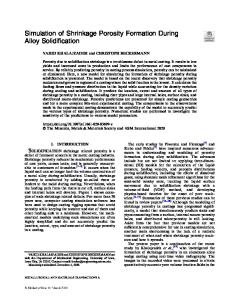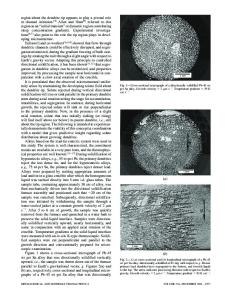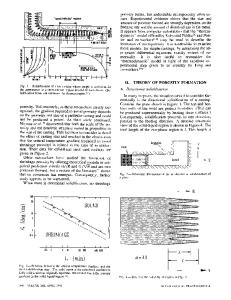Hydrogen evolution during directional solidification and its effect on porosity formation in aluminum alloys
- PDF / 451,065 Bytes
- 6 Pages / 612 x 792 pts (letter) Page_size
- 82 Downloads / 423 Views
I. INTRODUCTION
POROSITY, which occurs in almost all aluminum alloy castings, is detrimental to the mechanical properties and pressure-tightness of the castings.[1] As a result, research has been conducted on the formation of porosity for almost half a century.[2–9] It is well known that hydrogen is the only gas having a large solubility in the liquid aluminum alloy and a small solubility in the solid. On solidification, hydrogen is rejected by the growing solid and is enriched in the remaining liquid in the mushy zone. When the hydrogen concentration in the liquid exceeds its solubility, pores tend to form. The nucleation and growth of a pore is a process that consumes the supersaturation of hydrogen in the liquid. To model the formation of pores in a casting, both the hydrogen concentration and its solubility in the liquid need to be considered. The partition and diffusion of hydrogen during solidification governs the concentration of hydrogen in the liquid. Based on the fact that the diffusion coefficient of hydrogen is a few orders of magnitude higher than that of other solute elements in aluminum alloys,[10] the lever rule has been widely employed[4–9] for calculating the local hydrogen concentration in the liquid. The application of the lever rule results in the control volume shown in Figure 1 and a mass balance for hydrogen as shown in Eq. [1]: CS fS ⫹ CL fL ⫽ C0
[1]
where CS ⫽ the hydrogen concentration in the solid, CL ⫽ the hydrogen concentration in the liquid, C0 ⫽ the initial hydrogen concentration of the alloy,
Q. HAN, Research Staff Member, and S. VISWANATHAN, Senior Research Staff Member, are with the Oak Ridge National Laboratory, Oak Ridge, TN 37831-6083. Contact e-mail: [email protected] Manuscript submitted October 20, 2000. METALLURGICAL AND MATERIALS TRANSACTIONS A
fS ⫽ the local liquid fraction in the mushy zone, and fL ⫽ the local solid fraction in the mushy zone. As a result of the use of the lever rule for calculating the local hydrogen concentration, the enrichment of hydrogen in the liquid during solidification is only proportional to the local fraction of solid. This leads to a large error in calculating the hydrogen concentration in the liquid under certain conditions. It is due to the fact that (as will be shown later) hydrogen behaves very differently compared to most other solute elements during solidification. Before pores form, the concentration of hydrogen in the liquid is proportional to the total amount of hydrogen rejected by the solid from the start of solidification. This is shown in the large shaded area shown in Figure 1. For comparison, the control volume representing local fS and fL are also shown. As shown in Figure 1, the use of the lever rule using local fS underestimates the local hydrogen concentration in the liquid. As a result, the calculated hydrogen concentration is typically too low to satisfy the threshold concentration for pore nucleation based on classical nucleation and growth theory. This is one of the reasons why the nucleation and growth of pores cannot
Data Loading...










